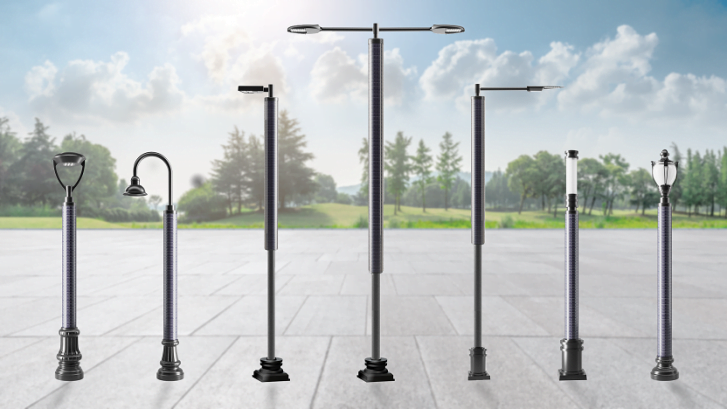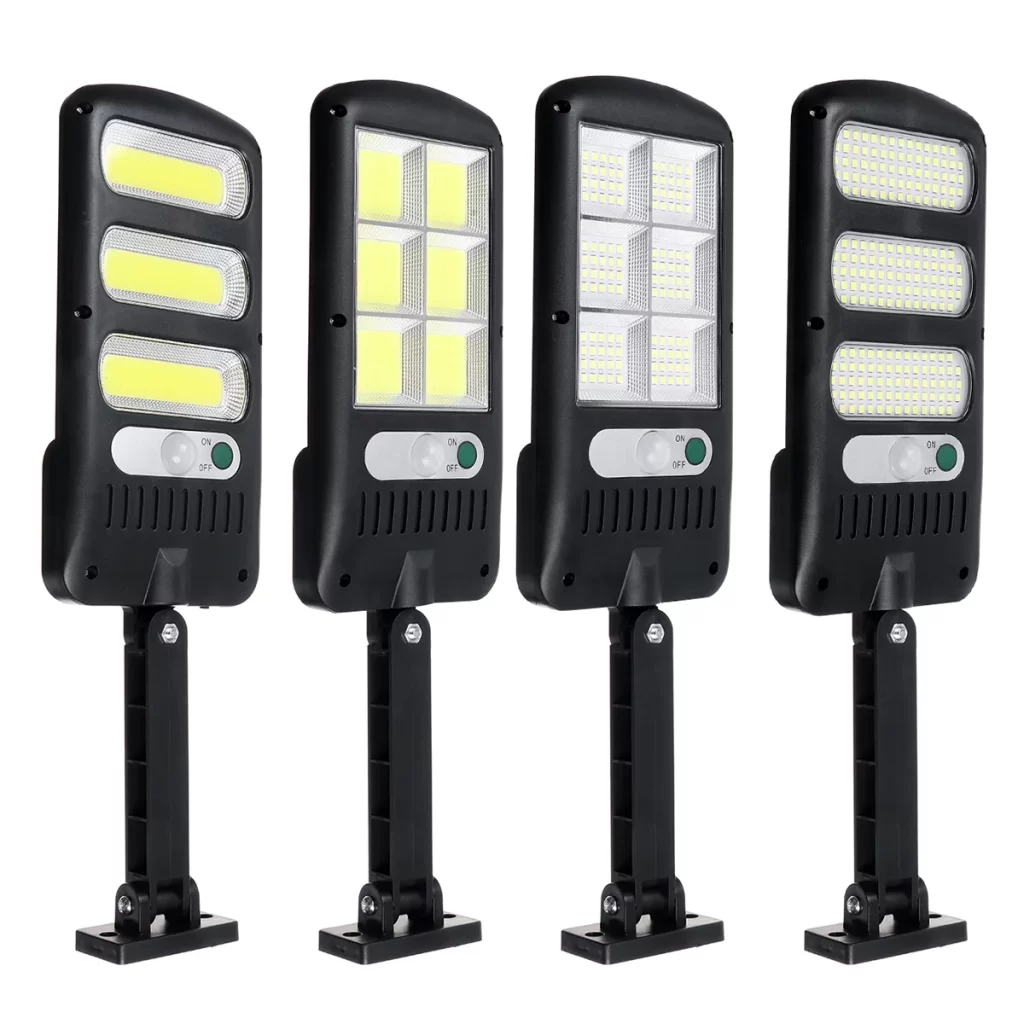The new energy industry has developed rapidly, and more and more rural areas have begun to install solar street lights. The number of solar street light manufacturers also increases. While some of them are tiny workshops, others are big, well-established technology companies. There are differences in both the price and the quality of their products. In this passage, we will analyze how much a solar street light usually costs from the perspective of its components: solar street light poles, solar photovoltaic panels, solar lithium batteries, solar lamps, and solar controllers. These five primary components are major factors impacting the pricing of solar street lights.
Solar street light poles

(1) Height of solar street light poles
Normally, the height of a solar street light pole refers to the height of the pole, not the overall height of the street light. However, in order to maximize profits, some manufacturers also calculate the height of the solar panel bracket, causing a difference of about 30 cm to 40 cm. In this way, the cost of producing solar street light poles can be greatly reduced.
(2) Thickness of solar street light poles
The thickness of the pole determines its firmness. At present, the mainstream thickness of 4–12 meters of solar street light poles on the market is 2.1mm, 2.3mm, 2.5mm, 2.75mm, 3.0mm, 3.5mm, and 4mm. Poles thicker than these ones need to be customized. A difference in thickness will make a lot of difference in price.
(3) Caliber of solar street light poles
The larger the pole diameter, the more stable the pole and the higher the wind resistance level. In terms of diameter, poles within 8 meters usually have a unified diameter, while poles above 8 meters generally have two common diameters.
(4) Galvanizing of solar street light poles
Currently, there are basically three types of galvanizing on the market: cold galvanizing, hot galvanizing, and hot dip galvanizing.
Cold galvanizing is the weakest at resisting corrosion and is the cheapest. It is commonly used for low-priced poles.
Hot galvanizing cannot be firm enough at the weld, and the galvanized layer is also thin. Its anti-corrosion performance is medium, but its cost effectiveness is the highest.
The cost of hot dip galvanizing is especially high. Poles with a thickness of more than 4 meters must go through hot dip galvanizing for anti-corrosion. Poles that have been hot dip galvanized resist corrosion and rust for 25 years.
(5) Flange of a solar street light pole
The thickness and size of the flange also affect the price to a small extent.
(6) Shape
Common styles of the light poles include A-shaped arm, conch arm, straight arm, etc. Their price doesn’t vary too much. But if you want to customize special shapes, the price will rise because of the production technology and labor costs. The cost will increase with the complexity of the design.
Solar street light lamps

(1) Lamp shell shape:
The costs of the lamp shell shape mainly depends on whether it involves patents. If it involves patents, the price may be several hundred dollars higher.
(2) Lamp material:
Die-cast aluminum lamps are the most popular ones, and they have an IP65 waterproof rating. Some cheap lamps use plastic shells, and the material is very thin. The lamp may be damaged even during installation.
(3) Selection of LED lamp beads:
From the perspective of power, we can divide LED lamps into four types: low power, medium power, high power, and COB LED lamps. Generally speaking, low-power and medium-power LEDs are basically used as indoor lamps because the power they need is relatively low. For outdoor lights like the street lamps, they usually use high-power lamp beads, and some also use COB lamp beads. But COB lamp beads are not the mainstream selection because their heat dissipation capability is low.
Lithium battery
(1) Capacity and material
The battery is the factor that affects the price the most in the entire street lamp system. The most common lithium iron phosphate battery can be 4-5 times cheaper than the ternary lithium battery.
(2) Disassembled battery:
Disassembled batteries are mainly the batteries disassembled from electric vehicles, electric buses, etc. and recycled and reused as lithium battery for solar energy applications. However, only a few professional and capable manufacturers can use them well. The premise of using disassembled batteries is to sort and group them, but few manufacturers have the cabinets required for these processes.
(3) Systems with different voltages
As lithium-ion phosphate batteries become more popular these years, more and more solar street lights apply the 3.2V low-voltage system because the 3.2V battery is cheaper than the 12V battery. The advantages of the 12V system are high power, high voltage, and low current, so it is relatively safe for electronic components. The disadvantages include being damaged easily because the battery cells are connected in series and the high cost. The 3.2V system can provide sufficient power for a relatively longer time, and the cells are connected in parallel. It has a longer cycle life, and the cost is low, so it is often used in solar street lights nowadays.
Solar panels
The choice between monocrystalline and polycrystalline solar panels is the primary cause of the disparity in the price of solar panels. Their differences are as follows:
(1) Different production processes
This is the root cause of the differences between monocrystalline and polycrystalline solar panels. Monocrystalline solar panels will go through the crystal-pulling process. After the silicon is melted into a liquid at a high temperature, it will be directed onto a certain rod. When the liquid on the contact surface slowly solidifies, the rod is pulled up a little. In this way, a row of crystalline silicon rods is gradually made, and then they are polished and sliced. After the slices are printed, they are classified according to conversion efficiency, electrical parameters, and appearance. Slices at the top are likely to have an A rating. The classification starts at A and ends at P. Slices with a P rating have lower efficiency.
The manufacturing of polycrystalline solar panels is done through the method of natural precipitation. After the silicon raw material is melted into a liquid at high temperature, it is poured into a cooling pool, where it will precipitate naturally. The impurities in it sink naturally due to their weight. The liquid gradually cools into solid crystalline silicon. Then they are cut into rectangular crystal columns. The crystalline silicon on top has fewer impurities and higher purity, so the conversion efficiency is also high.
(2) Different conversion efficiency
Monocrystalline silicon is led to the rod by its own tension. Since the impurities are heavier, they will not go up with the silicon. When the liquid decreases and there are only impurities at the bottom, this process will be completed. The material at the bottom can be added to new raw materials, and after smelting, it will naturally precipitate to form multi-crystals. So, the purity of single crystals is generally higher than that of multi-crystals, which makes their conversion efficiency higher.
(3) Different appearance
The four corners of the monocrystalline silicon crystal are rounded because it is pulled into a crystal rod, and the rounded corners are retained after grinding. Polycrystalline silicon has four right angles because it is cut into rectangular crystal columns. The color of the monocrystalline silicon crystal is dark blue, and the color after lamination is blue-black, while the color of the polycrystalline silicon is lighter, and the color after lamination is gray-blue. This is all affected by purity.
(4) Different costs
From the above analysis, it can be seen that there are more available materials for producing polycrystalline silicon, and the production efficiency is higher. Therefore, the cost is definitely cheaper than that of monocrystalline silicon. As raw materials become increasingly scarce, polycrystalline is being used by more manufacturers in small-scale power generation systems like solar street lights due to its high cost-effectiveness.
Solar controller
(1) Types
The solar controllers can be divided into integrated and independent ones. An integrated controller is combined with an aluminum substrate, and the cost is a little cheaper than an independent controller.
(2) Brand:
Controllers from mainstream brands will cost more than those from small brands.
Conclusions
In this passage, we have made a summary of the factors that will make a difference to the cost of the solar street lights. While choosing solar street lights, you can consider the poles, lamps, batteries, solar panels, and controllers to decide where you want to spend your budget and save as much as possible. If you want more advice on the costs of solar street lights, feel free to contact our sales for a specific quote and learn how to lower your costs!




